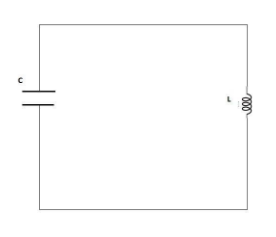Question
Question: What is the mechanical equivalent of spring constant \( k \) in LC oscillating circuits? (A) \( 1/...
What is the mechanical equivalent of spring constant k in LC oscillating circuits?
(A) 1/L
(B) 1/C
(C) L/C
(D) 1/LC
Solution
Hint
We know that in LC oscillation circuits, the energy in one of the two ( inductor or capacitor) gets transferred to the other and the process repeats like oscillation. Also, from kirchhoff’s law, we know that the sum of voltages around a closed path is always zero.
⇒V=q/C
where, V is the voltage across the capacitor, q is the charge held by the capacitor, C is the capacitance of the capacitor.
⇒V=L(di/dt)
Where, V is the back voltage of the inductor, L is the inductance of the inductor, i is the current flowing through the inductor.
Complete step by step answer

Now,
Let us assume q is the total charge in the capacitor. That means this charge is only constituting the energy of the capacitor and this is the only charge which would oscillate.
Then, Voltage across the capacitor, Vc=q/C
And, Voltage across the inductor, VL=L(di/dt)
Now, According to Kirchhoff’s law,
⇒Vc+ VL=0⋅⋅⋅⋅(1)
Substituting the values of Vc and VL in equation (1), we get
⇒q/C + L(di/dt)=0
Again, We know, i=dq/dt ⇒di/dt=d2q/dt2
Thus,
⇒q/C + L(d2q/dt2)=0⋅⋅⋅⋅(2)
Now, In case of Simple Harmonic Motion,
The equation was,
⇒kx + m(d2x/dt2)=0⋅⋅⋅⋅(3)
Where, k is the spring constant, x is the displacement, m is the mass of the body.
Comparing equation (2) and (3), we get
⇒k=1/C
Hence, the correct option is (B).
Note
The analogy between Simple Harmonic Motion and LC oscillation is very apparent. In the first case, the mass oscillates through the x parameter and in the latter, the charge oscillates through L. Again, for the first case, the k is the constant term and for the latter, C is the constant term.
